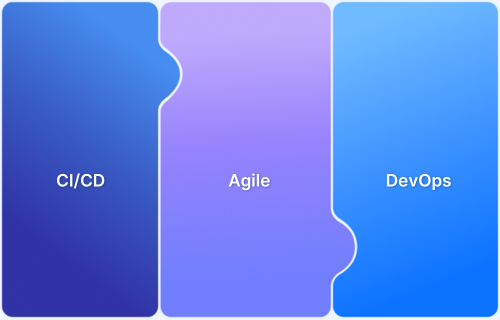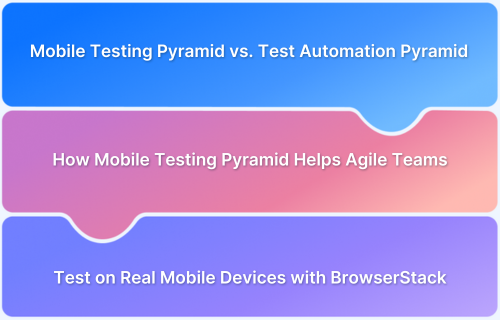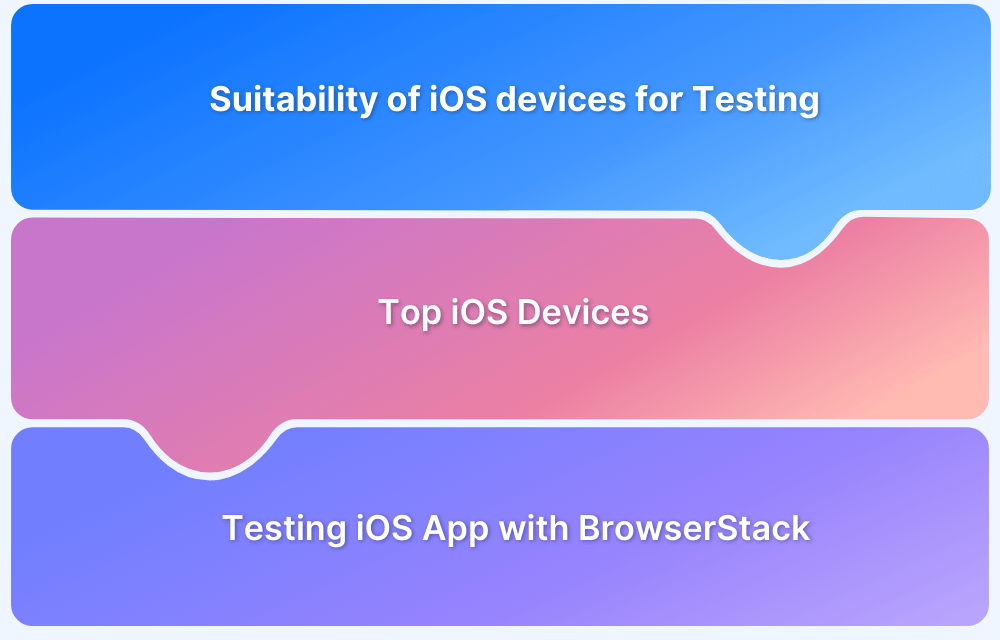Risk Based Testing Approach for Agile Teams
By Shreya Bose, Community Contributor - October 30, 2024
Risk based testing prioritizes high-risk areas of an application, focusing testing efforts on components most likely to fail or impact user experience.
Unlike traditional testing methods, this software testing approach that optimizes time and resources by evaluating software complexity and potential risk to identify critical areas.
This article will discuss what is risk-based testing in agile and some best practice on how to conduct it.
- What is Risk Based Testing?
- What is Risk Based Testing in Agile?
- Purpose of Risk Based Testing in Agile
- Techniques of Conducting Risk Based Testing
- What are the Phases of Risk Based Testing?
- Features of Risk Based Testing
- How to Conduct Risk Based Testing in Agile: Example
- Benefits of Risk Based Testing Approach
- Important Metrics for Risk Based Testing
- Checklist while conducting Risk Based Testing
- Best Practices for Conducting Risk Based Testing
What is Risk Based Testing?
The most common complaint that comes from software testing using the Agile method is the lack of time. Since the term is itself a synonym for speed, its emphasis on getting things done is self-explanatory. However, this brings up a burning question for every Agile tester in the world.
What features do we test first?
Most Agile sprints last a couple of weeks. That timeframe is undoubtedly not enough to test every or even most features of modern websites and apps. As development progresses, software becomes more complex and requires more tests to verify its functionality. Running thousands of tests is completely unfeasible, and testers must prioritize what needs to be tested within increasingly shorter timelines.
The answer lies in risk-based testing.
What does ‘risk’ mean?
Risk refers to the occurrence of an unforeseen event that can impact the success of a product (software, in this case). These events could have occurred in the past or may be a concern for future occurrences. Risks can serve as a reliable parameter to plan, schedule, and allocate tester effort.
What is Risk Based Testing in Agile?
Risk-based testing is an approach that helps Agile testers determine which features to test first by prioritizing based on risk.
Since Agile development emphasizes speed, there is often limited time within each sprint to test all features thoroughly. As applications become complex, effective prioritization becomes crucial, making it impractical to test everything.
Risk-based testing in Agile allows teams to manage time efficiently, even within the tight timelines of Agile sprints, ensuring reliable software quality without exhaustive testing of every component.
Purpose of Risk Based Testing in Agile
Risk-based testing applies the principles of risk management to testing activities. It aims to:
- Create and offer a framework that facilitates clear discussion between testers, developers, and other stakeholders about the risks at hand. Essentially, it isolates risks to make them identifiable and actionable.
- Cover customer needs as well as developer needs when considering what counts as a risk.
- Provides the criteria to decide how to manage budgets, negotiate timelines, avoid delay – all without affecting software quality.
- Highlights what features/issues matter most to customers, thus creating a hierarchy of testing requirements.
Who Performs Risk Based Testing in Agile?
In Agile environments, assessing software risks is a collaborative effort that involves testers, product owners, and scrum masters.
Testers conduct thorough risk assessments that guide the testing strategy, ensuring that critical features are prioritized. The risk of significant failures during production increases if the testing approach is lacking.
Risk-based testing focuses on critical areas, including:
- Defect-prone components
- Essential business functions
- Frequently used features
- Security measures
- Complex elements
- Recent changes
When to conduct Risk Based Testing in Agile?
Risk-based testing in Agile is valuable in specific scenarios.
Below are some situations on when to perform risk based testing:
- When projects face limitations, prioritizing testing efforts becomes crucial to maximize efficiency.
- For software with significant risk factors, such as inadequate domain knowledge or complex functionalities, focusing on high-risk areas ensures critical issues are addressed.
- Risk-based testing is essential for projects requiring security assessments, especially in cloud environments vulnerable to threats like SQL injection.
- It helps adapt project testing priorities with continuous modifications as new risks emerge.
Also Read: How to run Regression Testing in Agile Teams
Techniques of Conducting Risk Based Testing
Risk-based testing can be divided into two main categories: lightweight and heavyweight.
Both these risk-based testing techniques have different objectives and benefits.
Lightweight Risk Based Testing
This approach quickly identifies and addresses high-risk areas with minimal overhead, making it ideal for projects with limited time or resources.
Some of the key features include:
- Rapidly identifies high-risk areas through informal discussions and expert insights.
- Focuses testing efforts on high-risk areas, prioritizing based on potential impact.
- Encourages exploratory testing to uncover defects using testers’ intuition.
- Continuously monitors and reassesses risks throughout the testing lifecycle.
Heavyweight Risk Based Testing
This method offers a thorough and structured approach to risk assessment, suitable for complex projects or regulated industries.
Some of the key features include:
- Formal techniques like Failure Mode and Effects Analysis (FMEA) are used for risk evaluation.
- Involves detailed documentation of risks, including their impact and mitigation strategies.
- Integrates risk assessments into test planning for better resource allocation.
- Ensures comprehensive test coverage by focusing on high-risk areas.
- Provides regular updates on risk status and mitigation progress.
Also Read: What is a Test Plan in Agile?
What are the Phases of Risk Based Testing?
Risk-based testing follows a structured process to assess and manage software risks effectively.
Below are the key phases involved in risk-based testing:
- Risk Identification and Assessment using expert interviews, assessments, workshops, and past experiences. Communicate clearly within the development team to pinpoint vulnerabilities. Assess these risks for likelihood and impact.
- Create a risk register to categorize identified risks into sub-risks using a hierarchical structure for easy tracking and resource allocation.
- Analyze risks qualitatively and quantitatively, employing methods like the 3×3 grid to evaluate likelihood and impact.
- Use a Risk Assessment Matrix to prioritize risks by multiplying likelihood by severity.
- Create a Test Case Priority Grid to sort test cases based on risk ratings, ensuring high-priority tests are executed first to address significant risks early.
- Determine the level of detail required based on test case priority.
- Analyze whether identified risks require responses and consider options like adjusting the project plan or reallocating resources.
- Create contingency plans for unforeseen events and continuously track identified risks, monitoring new risks and evaluating changes.
For a holistic deep-dive into risk-based testing, check out this webinar on Shift in Testing and Continuous Delivery, in which Kavitha Appakayala (Senior Manager, Quality Engineering, eBay) breaks down the industry-wide shift in testing to achieve continuous delivery.
Features of Risk Based Testing
Below are the key features of risk based testing:
- Focuses on identifying and addressing high-risk areas more intensively than low-risk ones.
- It is an iterative approach that continually uncovers and breaks down risks for resolution.
- Test cases are prioritized, with higher-risk tests executed first to mitigate potential issues.
- More resources are dedicated to significant risks that may need thorough research and development.
- Testing efforts are aligned with risk levels. They are increased as risk severity rises.
How to Conduct Risk Based Testing in Agile: Example
Below is a step-by-step guide on how to conduct risk based testing in Agile with a real-world example.
For example, a software testing team is working on an eCommerce platform where customers can make online purchases.
The team has identified some key risks:
- The payment gateway is not secure, posing a threat of unauthorized access and potential theft of customer payment information.
- The search functionality does not return accurate results, leading to customer frustration and potential loss of sales.
- The checkout process is not user-friendly, which may result in abandoned shopping carts and a loss of sales.
Here’s how to perform risk-based testing for this situation:
Step 1: Identify Risks
- Include stakeholders in sprint planning sessions to discuss potential risks.
- Use techniques such as checklists and risk workshops to uncover potential risks.
- Document risks related to payment security, search accuracy, and checkout usability.
Step 2: Assess Risks
- Classify each identified risk as per possibility of occurrence
- Evaluate each risk’s potential impact on sprint goals and delivery.
- Arrange high to low-priority risks to fit the sprint’s timeline.
Step 3: Mitigate Risks
- Develop targeted testing strategies for high-priority risks.
- Allocate more resources for comprehensive testing of the payment gateway.
- Implement short, focused testing cycles on priority risks.
- Continuously adapt the risk plan based on sprint feedback and changing scope
Benefits of Risk Based Testing Approach
- Greater customer focus: Risk-based testing emphasizes thorough tests on features that affect customers most directly, AKA higher risks. This directly improves business performance, reduces the probability of negative reviews, and generally minimizes the impact of each identified risk.
- Better software quality: Risk-based testing focuses on finding higher risks first, and ensuring that the most important functions are testing first. Consequently, the software can be released with confidence in the fact that fundamental and customer-facing functions meet quality expectations.
- More structured testing: When risks are identified and their impact is quantified, it becomes easier to decide what to test, where to start, and stop testing. In other words, it becomes easier to define the scope of testing as well as test execution priority within limited timelines. This provides the structure needed to organize thousands of tests in every single development project.
Risk-based testing is frequently one of the most effective ways to implement Agile principles in software testing. By using a quantifiable parameter (i.e., risk) to determine which tests must be pushed up the ladder, QAs can accurately place tests in a hierarchy that serves the best interests of the software. This also serves customers and business owners’ interest, since risk-free software fosters high-quality user experiences and positive revenue streams.
With risk-based testing, all the above can be achieved in restricted schedules, thus implementing the very essence of Agile development and testing.
Important Metrics for Risk Based Testing
Below are some key metrics that are important for risk based testing:
- Number of test cases – planned vs. executed
- Number of test cases – passed vs. failed
- Number of risks identified – status and severity of each
- Number of critical risks – still open
- Instances of test environment downtime
- Test Summary Report
- Test Coverage Report
- Effort expended – scheduled vs. actual
- Schedule variation – planned vs. actual
- Percentage of risk identification
- Percentage of risk mitigation
- Percentage of defect leakage
Checklist while conducting Risk Based Testing
Here is an important checklist that should be followed while conducting risk based testing
- Identify potential risk areas related to project scope, complexity, technology, and critical requirements.
- Highlight functionalities that significantly impact financial or critical system functions.
- Evaluate each risk’s effect on project objectives, deadlines, and customer experience.
- Prioritize risks based on their impact, product complexity, and critical features.
- Focus on requirements and design aspects that can introduce security vulnerabilities.
- Create tests with integrated risk analysis and risk-focused test cases.
- Ensure test cases are scalable to accommodate new security or functional features.
- Leverage insights from past projects for better risk identification and mitigation.
- Allocate resources strategically to address high-priority risks effectively.
Best Practices for Conducting Risk Based Testing
Along with the checklist, consider these best practices to conduct effective risk based testing:
- Identify critical risks early in the planning phase for efficient management.
- Foster collaboration among developers, testers, and analysts (stakeholders) to uncover and prioritize risks.
- Conduct a detailed risk assessment to identify risks and understand their impact.
- Prioritize testing based on risk levels to focus on the most critical software components.
- Use BrowserStack Automate for test automation and test on real device cloud to streamline testing in high-risk areas, increase coverage, and test in real user conditions for accurate results.
- Continuously reassess risks throughout the development lifecycle for ongoing alignment with project needs.
Conclusion
Risk-based testing is a strategic approach that focuses testing efforts on the most critical functionalities of software or systems. By prioritizing high-impact areas, this method improves user experience and delivers higher-quality software.
BrowserStack Automate offers a robust solution for testing on real devices. BrowserStack Automate enables you to run tests across a diverse set of real devices and browsers, helping you identify issues that may not surface in virtual environments.




